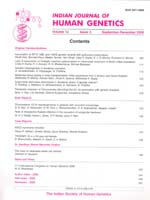
|
Indian Journal of Human Genetics
Medknow Publications on behalf of Indian Society of Human Genetics
ISSN: 0971-6866
EISSN: 0971-6866
Vol. 11, No. 2, 2005, pp. 80-83
|
 Bioline Code: hg05018
Bioline Code: hg05018
Full paper language: English
Document type: Research Article
Document available free of charge
|
|
|
Indian Journal of Human Genetics, Vol. 11, No. 2, 2005, pp. 80-83
| en |
Molecular characterization of mutations causing β -thalassemia in Faisalabad Pakistan using the amplification refractory mutation system (ARMS-PCR)
Baig ShahidM, Rabbi F, Hameed U, Qureshi JA, Mahmood Z, Bokhari SH, Kiani A, Hassan H, Baig JM, Azhar A, Zaman T
Abstract
BACKGROUND: Faisalabad is the third biggest city of Pakistan. Majority of the population is Punjabi while other ethnic groups are in minority.
AIMS: The present study was undertaken to find the mutations causing β -thalassemia in Faisalabad Pakistan.
MATERIALS AND METHODS: A total of 285 β -globin alleles from 143 unrelated families having at least one transfusion-dependent child were analyzed by using amplification refractory mutation system (ARMS-PCR).
RESULTS: FSC-8/9 (+G) and IVS-I-5 (G →C) were the most common mutations. The allele frequency for FSC-8/9 (+G) was 38.59% while frequency for IVS-I-5 (G →C) was 37.89%. The high frequency (76.48%) of IVS-I-5 (G →C) and FSC-8/9 (+G) on various alleles provides a strong evidence of intermarriages.
CONCLUSIONS: By using ARMS-PCR, the mutations were successfully characterized in 95.79% of subjects, while 4.21% remain to be characterized. This study will facilitate the implementations of genetic counseling and prenatal diagnosis in the population of Faisalabad.
Keywords
ARMS-PCR; β -thalassemia; mutations detection; Faisalabad; mutations; Pakistan.
|
| |
© Copyright 2005 Indian Journal of Human Genetics.
Alternative site location: http://www.ijhg.com/
|
|
